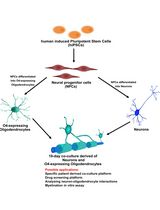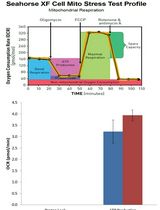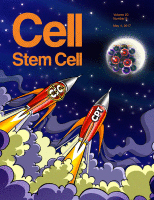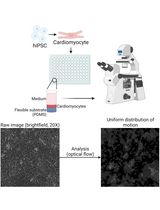- EN - English
- CN - 中文
Generation of Human iPSC-derived Neural Progenitor Cells (NPCs) as Drug Discovery Model for Neurological and Mitochondrial Disorders
人来源iPSC获得的神经祖细胞(NPCs)的产生作为神经和线粒体疾病的药物发现模型
发布: 2021年03月05日第11卷第5期 DOI: 10.21769/BioProtoc.3939 浏览次数: 9026
评审: Giusy TornilloThirupugal GovindarajanAnonymous reviewer(s)

相关实验方案

人 iPSC 衍生神经元与少突胶质细胞共培养用于髓鞘形成的小分子筛选分析
Stefanie Elke Chie [...] Maria Consolata Miletta
2025年05月05日 3117 阅读

利用Seahorse XFe96通量分析仪检测PBMC的线粒体应激反应,并比较Poly-D-Lysine与Poly-L-Lysine的细胞附着性能
Kumudu Subasinghe [...] Nicole Phillips
2025年06月05日 1770 阅读
Abstract
The high attrition rate in drug development processes calls for additional human-based model systems. However, in the context of brain disorders, sampling live neuronal cells for compound testing is not applicable. The use of human induced pluripotent stem cells (iPSCs) has revolutionized the field of neuronal disease modeling and drug discovery. Thanks to the development of iPSC-based neuronal differentiation protocols, including tridimensional cerebral organoids, it is now possible to molecularly dissect human neuronal development and human brain disease pathogenesis in a dish. These approaches may allow dissecting patient-specific treatment efficacy in a disease-relevant cellular context. For drug discovery approaches, however, a highly reproducible and cost-effective cell model is desirable. Here, we describe a step-by-step process for generating robust and expandable neural progenitor cells (NPCs) from human iPSCs. NPCs generated with this protocol are homogeneous and highly proliferative. These features make NPCs suitable for the development of high-throughput compound screenings for drug discovery. Human iPSC-derived NPCs show a metabolism dependent on mitochondrial activity and can therefore be used also to investigate neurological disorders in which mitochondrial function is affected. The protocol covers all steps necessary for the preparation, culture, and characterization of human iPSC-derived NPCs.
Graphic abstract:

Schematic of the protocol for the generation of human iPSC-derived NPCs
Background
In recent years, the downsides of target-centered drug discovery have become evident, in particular for programs addressing neurological diseases (Paul et al., 2010). The challenges of target-based drug discovery led to the revival of phenotypic drug discovery. Phenotypic screenings require the identification of a disease-specific trait (phenotype) that can be modulated within the physiological environment of a cell or organism (Khurana et al., 2015). This approach has the advantage of identifying compounds that show an effect within complex biological environments. At the same time, phenotypic drug discovery requires the presence of a robust disease-relevant phenotype that can be efficiently modulated using a reliable high-throughput detection method. Current drug discovery pipelines strongly rely on cancer-derived immortalized cell lines that lack the functional properties of brain cells. Moreover, immortalized cell lines are mostly glycolytic and less sensitive to mitochondrial impairment than neuronal cells (Bénit et al., 2016). Therefore, immortalized cells are not an effective drug discovery model for neurological diseases and diseases in which mitochondrial oxidative phosphorylation (OXPHOS) is dysfunctional, such as mitochondrial disorders and neurodegeneration (Cunnane et al., 2020).
An important breakthrough in the field of neuronal disease modeling and drug discovery is represented by cellular reprogramming technologies. Cellular reprogramming allows the conversion of the identity of a given cell, thereby enabling the generation of brain cells from patient-specific somatic cells. Cellular conversion can be accomplished through the derivation of induced pluripotent stem cells (iPSCs) (Takahashi et al., 2007) or through the process of direct conversion, which can reprogram skin cells directly into post-mitotic induced neurons (iNs) (Vierbuchen et al., 2010). iPSCs can also be used to derive three-dimensional (3D) cerebral organoids that may recapitulate the organization of the developing human brain (Lancaster et al., 2013).
In order to perform meaningful phenotypic screens, it is necessary to use disease-relevant cellular models. Among reprogramming-derived cell types, patient-specific neural progenitor cells (NPCs) appear particularly well suited for phenotypic drug discovery of neurological diseases, given their homogeneous features, cost-effective culture conditions, and mild proliferative state. Indeed, iPSC-derived NPCs have been successfully employed for drug discovery in the context of neurological and neuropsychiatric disorders (Lorenz et al., 2017; Readhead et al., 2018; Walter et al., 2019).
During the process of neurogenesis, which is characterized by a metabolic shift from glycolysis to OXPHOS (Zheng et al., 2016), NPCs represent the first cell type to depend on mitochondrial respiration (Beckervordersandforth, 2017; Lorenz and Prigione, 2017). Since NPCs show sensitivity to conditions that impair OXPHOS, they can be used as an effective cell model to carry out high-throughput screenings for neurological and mitochondrial diseases. Accordingly, iPSC-derived NPCs from patients affected by mitochondrial diseases exhibited meaningful phenotypes that could be harnessed to perform phenotypic compound screenings (Lorenz et al., 2017). Altogether, iPSC-derived NPCs might be instrumental for identifying novel treatments in the context of neurological and mitochondrial diseases that are hard to model using conventional drug discovery systems (Inak et al., 2017).
Here, we describe in detail the generation and maintenance of human iPSC-derived NPCs. Different protocols can be used to obtain these cells. Some protocols give rise to NPC populations with limited proliferative features (Elkabetz et al., 2008), while others may depend on the addition of human LIF, which makes culturing the cells very cost-intensive (Li et al., 2011). However, most useful approaches rely solely on small molecule to produce highly proliferative NPC populations (Reinhardt et al., 2013). A key characteristic of these NPCs is their capability of robust and homogenous expansion. At the same time, NPCs should be able to efficiently differentiate into neuronal and glial cell types (Reinhardt et al., 2013; Lorenz et al., 2017).
Our approach is based on the protocol of Reinhardt et al. ( 2013) and was published in Lorenz et al. (2017) for drug discovery applications in the context of neurological mitochondrial diseases. The protocol allows the generation of NPCs that maintain their characteristics under chemically defined conditions over several passages and can be readily differentiated into the desired brain cell types. The protocol is highly reproducible and leads to homogenous cell populations. It is similarly effective starting from human embryonic stem cells, healthy control iPSCs, and patient-specific iPSCs (Lorenz et al., 2017).
To initiate neural induction, bone morphogenic protein (BMP) inhibitor dorsomorphin (DM), and transforming growth factorβ (TGFβ)-signaling inhibitor SB43152 (SB) are supplemented to the basic NPC media (BM1). Purmorphamine (PU) and CHIR99021 (CHIR) are added to stimulate the sonic hedgehog (SHH) signaling pathway, inhibit glycogen synthase kinase-3 (GSK3), and activate canonical WNT signaling (Chambers et al., 2009; Kim et al., 2010). After the first days in the induction medium, embryoid bodies (EBs) form neuroepithelial structures (Figure 1A). After 6 days, the EBs are gently dissociated and seeded on Matrigel-coated plates for purification. Neural progenitor morphology becomes homogenous after 4-6 passages post neural induction (Figure 1A). NPCs should express typical NPC markers such as NESTIN, PAX6, SOX1, SOX2, and DACH1. Spontaneous differentiation of cells expressing the pan-neuronal marker TUJ1 is always present (Figure 1C-1D). Conversely, pluripotency markers like OCT4, NANOG, DNMT3B, and DPPA4 should be downregulated compared to the parental iPSC lines. NPCs retain their multipotent identity over multiple passages (> 30) as well as after freezing and thawing without changes in cell morphology.
The following step-by-step protocol allows the experimenter to obtain human iPSC-derived NPCs with a high degree of homogeneity within 4-8 weeks, and to culture and characterize the cells for subsequent use in disease modeling or drug discovery applications.
Materials and Reagents
The following list provides examples of the materials and equipment that we routinely use in our laboratory. Nevertheless, reagents and equipment with similar specifications will work as well.
Cellstar cell culture multiwell plates (6-24 well) (Greiner Bio-One, catalog numbers: 657 160 [6-well; 665 180 [12-well]; 662 160 [24-well])
Corning 60 mm Ultra-low attachment culture dish (Corning, catalog number: 3261 )
Cell spatula (TPP, catalog number: 99010 )
Serological pipettes (Greiner Bio-One, catalog numbers: 760180 [2 ml]; 606180 [5 ml]; 607180 [10 ml]; 760107 .html"> 760107 [25 ml]; 768160 [50 ml])
BemisTM Curwood ParafilmTM M Laboratory Film (Fisher Scientific, product code HS234526C, catalog number: 10018130 )
Greiner centrifuge tubes (50 ml and 15 ml) (Sigma-Aldrich, manufacturer: Greiner; catalog number for 15 ml: T1818 , for 50 ml: T2318 )
Liquid nitrogen
Corning ® Matrigel ® Growth Factor Reduced (GFR) Basement Membrane Matrix, Phenolred-free, LDEV-free (Corning, CAS number: 356231 , format: 10 ml, store at -20 °C and follow instructions from supplier for preparation)
CHIR 99021 (Caymen Chemical, CAS number: 252917-06-9, catalog number: 13122 ; product format: 2.5 mg/ml in DMSO; storage at -20 °C as 6 mM stock; stability: ≥ 2 years)
SB431542 in solution (MACS Miltenyi, CAS number: 130-106-543 , catalog number: 130-106-543 ; product format: 10 mM in DMSO; storage at -20 °C as 10 mM stock, protected from light; stability: 6 months)
Dorsomorphin (StemCell; CAS number: 866405-64-3, catalog number: 72102 ; product format 10 mg solid; storage at -20 °C as 5 mM stock in DMSO (heat applied) or ethanol; stability: 12 months)
Purmorphamin (MACS Miltenyi, CAS number: 483367-10-8; catalog number: 130-104-465 product format: 5 mg solid; storage at -20 °C as 10mM stock in DMSO, protected from light)
(+)-Sodium L-ascorbate (Vitamin C) (Merck, Sigma-Aldrich, catalog number: A4034 ; product format solid powder; store as 200 µM stock in water at -20 °C)
N-2 Supplement (100×) (Thermo Fisher Scientific, Gibco, catalog number: 17502-048 ; product format: 5 ml liquid; store at -20 °C, protected from light; stability: 18 months)
B27 without Vitamin A (50×) (Thermo Fisher Scientific, Gibco, catalog number: 12587010 ; product format: 10 ml liquid; store at -20 °C protected from light)
Neurobasal® Medium (Thermo Fisher Scientific, Gibco, catalog number: 21103049 ; product format: 500 ml liquid; store at 2-8 °C, protected from light; shelf life: 12 months)
DMEM/F12, HEPES (Thermo Fisher Scientific, Gibco, catalog number: 31330038 ; product format: 500 ml liquid; store at 2-8 °C, protected from light; shelf life: 12 months)
KnockOut DMEM (Thermo Fisher Scientific, Gibco, catalog number: 10829018 ; product format: 500 ml liquid; store at 2-8 °C protected from light
KnockOut Serum replacement (Thermo Fisher Scientific, Gibco, catalog number: 10828010 ; product format: 500 ml liquid; store at -20 °C protected from light
StemMACSTM iPS-Brew XF, human (MACS Miltenyi Biotec, catalog number: 130-104-368 )
mTeSRTM1 (STEMCELL Technologies, catalog number for 500 ml kit: 85850 )
Penicilin-Streptomycin (P/S; 10,000 U/ml Penicilin, 10,000 µg/ml Streptomycin) (Thermo Fisher Scientific, Gibco, catalog number 15140122 ; product format: 100 ml liquid; store at -20 °C; shelf life: 12 months)
L-Glutamine (200 mM) (Thermo Fisher Scientific, Gibco, Catalog number: 25030081 ; product format: 100 ml liquid; store at -20 °C, protected from light; shelf life: 24 months)
Non-essential amino acids (NEAA, 100×) (Thermo Fisher Scientific, Gibco, catalog number: 11140035 , product format: 100 ml, store at 2-8 °C; shelf life: 12 months)
Sodium pyruvate (100 mM) (Thermo Fisher Scientific, Gibco, catalog number: 11360070 ; product format: 100 ml; store at 2-8 °C protected from light; shelf life: 12 months)
MycoZap Plus-CL (Lonza, catalog number VZA-2012 ; product format: 20 ml liquid; store at -20 °C, protected from light)
StemProTM AccutaseTM Cell Dissociation Reagent (Thermo Fisher Scientific, Gibco/StemPro, catalog number: A1110501 ; product format: 100 ml liquid, store at -20 °C, protected from light)
DPBS (without calcium and magnesium) (Thermo Fisher Scientific, Gibco, catalog number: 1419025 0; product format: 500 ml liquid; store at 15-30 °C; shelf life: 36 months)
ROCK inhibitor (RI), Y-27632, dihydrochloride (Enzo, CAS number: 129830-38-2; catalog number: ALX-270-333-M005 ; product format 5 mg powder; store at -20 °C; soluble in DMSO as 25 mg/ml; stability: stock solution stable for 1 month at -20 °C)
UltraPureTM 0.5 M EDTA (Invitrogen, catalog number: 15575020 )
Bambanker (NIPPON Genetics, catalog number: BB03 )
ShandonTM Immu-MountTM (Thermo ScientificTM, catalog number: 77-86-1 ; reference number 9990402; product formal: 20 ml)
Anti-Nestin Antibody, clone 10C2 (Millipore, catalog number: MAB5326 ; Brand family: Chemicon®)
Anti-Pax-6 Antibody (Covance, catalog number: 901301 )
SOX2 antibody (R&D Systems, catalog number: AF2018 )
DACH1 antibody (ProteinTech, catalog number: 10914-1-AP )
Anti-β-Tubulin III (TUJ-1) (Sigma-Aldrich, catalog number: T8578 )
MAP2 (Synaptic system, catalog number: 188004 )
Hoechst 33342 (Hoechst) (InvitrogenTM, catalog number: H3570 )
16% Paraformaldehyde Aqueous Solution (PFA) (Electron Microscopy Sciences; catalog number: 50-980-487 )
Tween-20 (Sigma-Aldrich, catalog number: P9416 )
TritonTM-X100 (Sigma-Aldrich, catalog number: T8532 )
Alexa FluorTM 488 donkey anti-rabbit IgG (H+L) secondary antibody (Thermo Fisher Scientific, catalog number: A-21206 )
Alexa FluorTM 647 donkey anti-mouse IgG (H+L) secondary antibody (Thermo Fisher Scientific, catalog number: A-31571 )
Donkey anti-goat Cy 3 (Sigma-Aldrich, catalog number: AP180C )
Donkey anti-guinea pig Cy 3 (Sigma-Aldrich, catalog number: AP193C )
SYBRTM Green PCR Master Mix (Thermo Fisher Scientific, catalog number: 4309155 )
M-MLV Reverse Transkriptase (Invitrogen, catalog number: 28025013 )
RNeasy Mini Kit (50) (Qiagen, catalog number: 74104 )
Rnase-Free Dnase Set (50) (Qiagen, catalog number: 79254 )
Oligo(dT) 12-18 Primer (Invitrogen, catalog number: 18418012 )
dNTP-Mix (10 mM) (Invitrogen, catalog number: 18427088 )
MicroAmpTM Optical 348-well-reaction plate with barcode (Thermo Fisher Scientific, catalog number: 4343814 )
Basic medium 1 (BM1) (see Recipes, Table 1)
BM2 (sm-) medium (see Recipes, Table 1)
M1 medium (see Recipes, Table 2)
M2 medium (see Recipes, Table 2)
M3 (sm+) medium (see Recipes, Table 2)
Equipment
Centrifuge (Eppendorf, model: 5810R )
Water bath (Thermo Fisher Scientific, FisherbrandTM IsotempTM Digital-Control Water Baths: Model 220 )
CO2 incubator for cell culture (Thermo Fisher Scientific, model: Heraeus BBD 6 220 )
Hypoxia incubator for iPSC culture (Binder GmbH, model: Binder BCB 160 )
qPCR machine (Thermo Fisher Scientific, model: ViiA 7 )
Confocal Microscope system (Zeiss, model: Axio Imager Z1 )
Freezing container (Nalgene, model: Mr. Frosty; Corning CoolCellTM)
-80°C Freezer (New Brunswick, model: Innova 4725 )
Laminar flow hood (BDK, Luft und Reinraumtechnik GMBH)
Sterile scissor (for example: Surgical scissors, sharp, Sigma-Aldrich, catalog number: Z265977 )
Shaker (Rocky, LTF Labortechnik)
Procedure
文章信息
版权信息
© 2021 The Authors; exclusive licensee Bio-protocol LLC.
如何引用
Zink, A., Lisowski, P. and Prigione, A. (2021). Generation of Human iPSC-derived Neural Progenitor Cells (NPCs) as Drug Discovery Model for Neurological and Mitochondrial Disorders. Bio-protocol 11(5): e3939. DOI: 10.21769/BioProtoc.3939.
分类
干细胞 > 多能干细胞 > 细胞分化
神经科学 > 神经系统疾病 > 细胞机制
细胞生物学 > 细胞新陈代谢 > 呼吸测量法
您对这篇实验方法有问题吗?
在此处发布您的问题,我们将邀请本文作者来回答。同时,我们会将您的问题发布到Bio-protocol Exchange,以便寻求社区成员的帮助。
提问指南
+ 问题描述
写下详细的问题描述,包括所有有助于他人回答您问题的信息(例如实验过程、条件和相关图像等)。
Share
Bluesky
X
Copy link









